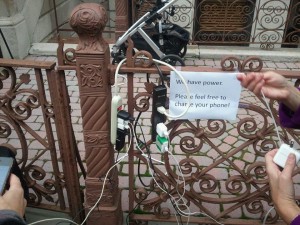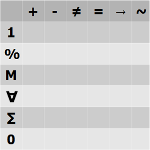My Prediction for the 2012 Presidential Election
Is Romney revolting? Is Obama offensive? Was Ron Paul prevented? I predict most people will be unhappy with the 2012 Presidential election. But there is a cure.
Predicting most people will be unhappy is simple math. Polls show a very tight race between Romney and Obama. If the country were perfectly divided then half the people would be unhappy with the decision. Since there is a substantial amount of people who want someone other than those two that means the majority of people will be unhappy with the result of the election.
What is the cure? More alternatives! No, not more candidates. Electing any one person causes a win lose situation. That will always result in someone being upset and quite often the majority will be unhappy with the result. The cure is more alternatives than electing a president.
Amazingly there are 1,296 alternatives related to any choice. I suspect you never realized those 1,296 alternatives even existed.
The 1,296 alternatives aren’t political parties or even candidates. No matter who is selected for president it’s the same type of choice. It’s a choice for someone else to make your decisions.
To make matters worse, you don’t even get to choose who chooses for you.
Let that sink in a bit. Every decision at the federal level and most decisions at the state and even local level are made by someone other than you. Not only are those choices made by someone other than you, it’s someone who doesn’t even personally know you. How in the world do you think they’ll choose what you want?
The cure is simple, choose a different set of the 1,296 alternatives. So, what are these 1,296 alternatives?
For any decision there is who makes the decision and the actual decision itself. Each of those can be further broken down into categories of 6 Directions and 6 Scales. The 6 Directions and 6 Scales form a grid of 36 Alternatives. The combination of 36 Who Decides and 36 Decisions forms a total of 1,296 Alternatives.
Lets examine Who decides to get a better understanding of the Alternatives.
6 Scales for Who Decides:
- Single 1: One person or type of person decides. Example: individual decision.
- Partial %: Some people decide. Example: Voting where a % makes the decision.
- Multiple M: More than one person required to make a decision. Example: Having a baby requires two people.
- Any ?: Anyone can decide. Example: Freedom, choices over your own property.
- All ?: Everyone required to decide. Example: Criminal jury trial, all 12 members must agree to convict.
- None 0: No one decides. Example: Left to chance. Decision is prohibited.
6 Directions for Who Decides
- Direct +: The person or people directly involved in doing or benefiting from the action make the decision. Examples: personal choice, buying something for cash.
- Opposite -: Decided by a person or persons who oppose the action or who will be harmed by the action. Example: veto.
- Other ?: Someone other than the person it affects. Example: government official.
- Same =: Person stays the same or person is neutral. Examples: Life time appointment. Judge.
- Stabilize ?: Starts as a different alternative before stabilizing: Example: tie breaker.
- Changing ~: Person who decides changes. Example: taking turns deciding.
President is a Single Other Alternative. Other examples of Single Other are: parent, boss, or criminal such as a mugger or rapist.
Nearly all elections in the USA are Partial Other. Either through the party system, or ballot access rules someone else has filtered your available choices.
Supposedly everyone is allowed to vote but people under 18 are not allowed and in many states prisoners are banned from voting. Also people without a fixed address or who split their time between places are only allowed to vote in elections in one place. That means they are prohibited from voting on issues or officials who affect their lives.
So all elections in the USA are Partial Other. That means only 2 of the 36 Alternatives for Who Decides are even offered as choices. That is less than 6% of the Alternatives for Who Decides.
Who Decides isn’t even the most important choice. What you really care about is the actual decision. Again there are 36 Alternatives for the Decision.
6 Scales for Decision
- Single 1: Single decision. Decide once.
- Partial %: Partial decision. Sometimes decide.
- Multiple M: Decide on many things. Decide many times. Multiple alternatives to arrive at decision.
- Any ?: Any option is possible. Decide anytime.
- All ?: All options without compromise. Everything you want. Always decide, not left to chance. Continuously. Continuously decide, moment to moment.
- None 0: Never decide, leave up to chance. Decide to never do it.
6 Directions for Decision
- Direct +: Decide for action. Decision directly connected to the action.
- Opposite -: Decide against action. Decide for opposing action. Decision causes opposite action.
- Other ?: Decide another choice. Action caused `by a different decision.
- Same =: Don’t change existing. Neutral choice. Same choice.
- Stabilize ?: Decision stabilizes. Becomes decision. Starts undecided or as a different decision then becomes the final decision.
- Changes ~: Decision changes. Effect of the decision changes.
Decisions made by government almost always are Single Direct decisions causing You to Pay More Taxes or Single Opposite denying your right to do something. The decisions are single because most laws are never repealed.. So again only 2 of the 36 Alternatives. Combined with Who decides only 0.3% of the Alternatives are ever offered. No wonder so many people complain about government.
Out of 1,296 possible Alternatives 99.7% are ignored.
The 1,296 Alternatives don’t only apply to politics, these are the Alternatives for any decision. This forms the basis of business strategy. The goal of innovation is to satisfy unmet desires. Understanding all of the decisions potential customers can make gives you a significant advantage.
Charity, proof scarcity doesn't always increase prices.
 Economic theory states that scarcity increases prices; but, exactly the opposite occurs. People share with their neighbors.
Economic theory states that scarcity increases prices; but, exactly the opposite occurs. People share with their neighbors.
Widespread power outages is the definition of scarcity. The people people without electricity clearly have a need. Why didn’t it lead to massive profit taking? In a real free market there is another choice, it’s call charity.
The person sharing their electricity didn’t have a scarcity, they had an abundance, more than they needed. The value of helping people in need outweighed any monetary profit or the hassle involved in selling access to electricity. This situation shows that given the choice people gladly share. If there isn’t a significant cost involved sharing people will share.
Accidentally wrote a book
I just printed out a copy of each report I wrote about Predictive Innovation® and discovered I have enough material for a 112 page book. I guess I’ll be reformatting these and publish them for sale.




 Predictive Innovation Training
Predictive Innovation Training Predictive Innovation: Core Skills Book
Predictive Innovation: Core Skills Book RoundSquareTriangle.com
RoundSquareTriangle.com